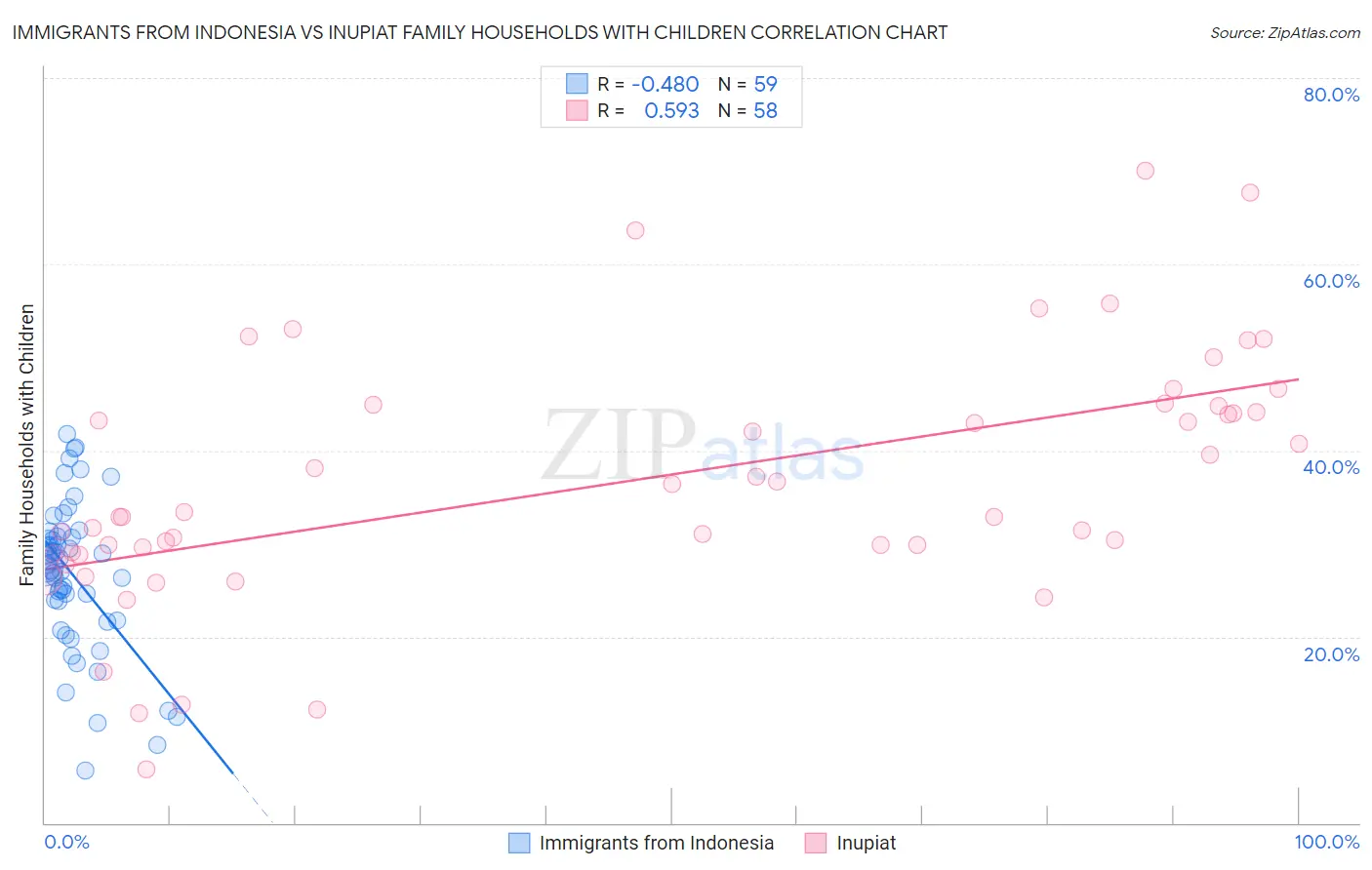Immigrants from Indonesia vs Inupiat Family Households with Children
COMPARE
Immigrants from Indonesia
Inupiat
Family Households with Children
Family Households with Children Comparison
Immigrants from Indonesia
Inupiat
28.5%
FAMILY HOUSEHOLDS WITH CHILDREN
99.9/ 100
METRIC RATING
72nd/ 347
METRIC RANK
32.8%
FAMILY HOUSEHOLDS WITH CHILDREN
100/ 100
METRIC RATING
2nd/ 347
METRIC RANK
Immigrants from Indonesia vs Inupiat Family Households with Children Correlation Chart
The statistical analysis conducted on geographies consisting of 215,654,509 people shows a moderate negative correlation between the proportion of Immigrants from Indonesia and percentage of family households with children in the United States with a correlation coefficient (R) of -0.480 and weighted average of 28.5%. Similarly, the statistical analysis conducted on geographies consisting of 96,318,609 people shows a substantial positive correlation between the proportion of Inupiat and percentage of family households with children in the United States with a correlation coefficient (R) of 0.593 and weighted average of 32.8%, a difference of 15.2%.

Family Households with Children Correlation Summary
| Measurement | Immigrants from Indonesia | Inupiat |
| Minimum | 5.7% | 5.8% |
| Maximum | 41.8% | 70.0% |
| Range | 36.1% | 64.2% |
| Mean | 26.6% | 36.6% |
| Median | 27.4% | 33.1% |
| Interquartile 25% (IQ1) | 21.7% | 29.1% |
| Interquartile 75% (IQ3) | 30.8% | 44.8% |
| Interquartile Range (IQR) | 9.0% | 15.7% |
| Standard Deviation (Sample) | 8.0% | 13.3% |
| Standard Deviation (Population) | 7.9% | 13.2% |
Similar Demographics by Family Households with Children
Demographics Similar to Immigrants from Indonesia by Family Households with Children
In terms of family households with children, the demographic groups most similar to Immigrants from Indonesia are Burmese (28.5%, a difference of 0.010%), Immigrants from Honduras (28.5%, a difference of 0.020%), Iraqi (28.5%, a difference of 0.030%), Laotian (28.5%, a difference of 0.040%), and Immigrants from Korea (28.5%, a difference of 0.080%).
| Demographics | Rating | Rank | Family Households with Children |
| Hondurans | 99.9 /100 | #65 | Exceptional 28.5% |
| Immigrants | Egypt | 99.9 /100 | #66 | Exceptional 28.5% |
| Ghanaians | 99.9 /100 | #67 | Exceptional 28.5% |
| Houma | 99.9 /100 | #68 | Exceptional 28.5% |
| Immigrants | Korea | 99.9 /100 | #69 | Exceptional 28.5% |
| Immigrants | Honduras | 99.9 /100 | #70 | Exceptional 28.5% |
| Burmese | 99.9 /100 | #71 | Exceptional 28.5% |
| Immigrants | Indonesia | 99.9 /100 | #72 | Exceptional 28.5% |
| Iraqis | 99.9 /100 | #73 | Exceptional 28.5% |
| Laotians | 99.9 /100 | #74 | Exceptional 28.5% |
| Immigrants | Jordan | 99.9 /100 | #75 | Exceptional 28.4% |
| Immigrants | Sri Lanka | 99.9 /100 | #76 | Exceptional 28.4% |
| Nigerians | 99.8 /100 | #77 | Exceptional 28.4% |
| Immigrants | Nepal | 99.8 /100 | #78 | Exceptional 28.4% |
| Immigrants | Iraq | 99.8 /100 | #79 | Exceptional 28.4% |
Demographics Similar to Inupiat by Family Households with Children
In terms of family households with children, the demographic groups most similar to Inupiat are Immigrants from Mexico (31.6%, a difference of 3.9%), Mexican (31.4%, a difference of 4.7%), Tongan (31.2%, a difference of 5.1%), Immigrants from India (31.0%, a difference of 5.8%), and Immigrants from Central America (31.0%, a difference of 6.1%).
| Demographics | Rating | Rank | Family Households with Children |
| Yup'ik | 100 /100 | #1 | Exceptional 37.0% |
| Inupiat | 100 /100 | #2 | Exceptional 32.8% |
| Immigrants | Mexico | 100.0 /100 | #3 | Exceptional 31.6% |
| Mexicans | 100.0 /100 | #4 | Exceptional 31.4% |
| Tongans | 100.0 /100 | #5 | Exceptional 31.2% |
| Immigrants | India | 100.0 /100 | #6 | Exceptional 31.0% |
| Immigrants | Central America | 100.0 /100 | #7 | Exceptional 31.0% |
| Yakama | 100.0 /100 | #8 | Exceptional 30.8% |
| Thais | 100.0 /100 | #9 | Exceptional 30.6% |
| Immigrants | Fiji | 100.0 /100 | #10 | Exceptional 30.5% |
| Nepalese | 100.0 /100 | #11 | Exceptional 30.5% |
| Immigrants | Pakistan | 100.0 /100 | #12 | Exceptional 30.2% |
| Afghans | 100.0 /100 | #13 | Exceptional 30.2% |
| Bangladeshis | 100.0 /100 | #14 | Exceptional 30.1% |
| Immigrants | South Central Asia | 100.0 /100 | #15 | Exceptional 30.0% |